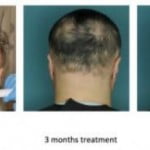A new, large cohort analysis from the prospective Prostate, Lung, Colorectal and Ovarian (PLCO) Cancer Screening Trial, indicates that men who had moderate baldness affecting both the front and the crown of their head at age 45 were at a 40% increased risk of developing aggressive prostate cancer (usually indicates a faster growing tumor resulting in poorer prognosis relative to non-aggressive prostate cancer) later in life, compared to men with no baldness. There was no significant link between other patterns of baldness and prostate cancer risk. The study, published September 15 in the Journal of Clinical Oncology, supports earlier research suggesting that male pattern baldness and prostate cancer may be linked.
“Our study found an increased risk for aggressive prostate cancer only in men with a very specific pattern of hair loss, baldness at the front and moderate hair-thinning on the crown of the head, at the age of 45. But we saw no increased risk for any form of prostate cancer in men with other hair-loss patterns,” said senior study author Michael B. Cook, PhD, an investigator in the Division of Cancer Epidemiology and Genetics at the National Cancer Institute in Bethesda, MD. “While our data show a strong possibility for a link between the development of baldness and aggressive prostate cancer, it’s too soon to apply these findings to patient care.”
Prostate cancer is the second most common cancer among men. Emerging evidence suggests that prostate cancer and male pattern baldness — progressive scalp hair-loss in a distinct pattern — are both connected to increased levels of male sex hormones (androgens) and androgen receptors, supporting the idea of a biological link between baldness and prostate cancer development and progression.
Researchers analyzed male pattern baldness in relation to prostate cancer risk in a cohort of 39,070 men from the U.S. PLCO Cancer Screening Trial, aged 55-74 years at enrollment. The men received a questionnaire that asked them to recall what their hair-loss patterns were at age 45 using a pictorial tool.
During follow-up, 1,138 prostate cancer cases were diagnosed, 51% of which were aggressive (Gleason score equal to or greater than 7, stage III or IV, or prostate cancer as the cause of death). The mean age at the time of prostate cancer diagnosis was 72.
Men who had a specific pattern of baldness, frontal and moderate crown (vertex), were 40% more likely to develop aggressive prostate cancer, compared to men who had no baldness. There was no association between male pattern baldness and risk of non-aggressive prostate cancer.
Dr. Cook stated that if these findings are confirmed by further studies, medical assessment of baldness could possibly be used to help identify men who may be at increased risk of aggressive prostate cancer. His research team is currently conducting two additional cohort analyses exploring the relationship between male pattern baldness and risk of developing and dying from prostate cancer. One of the studies includes a baseline dermatologic assessment of male pattern baldness, which may be more reliable than the recall method, which was used in the present study. This research was supported by the intramural program of the U.S. National Cancer Institute, National Institutes of Health.



